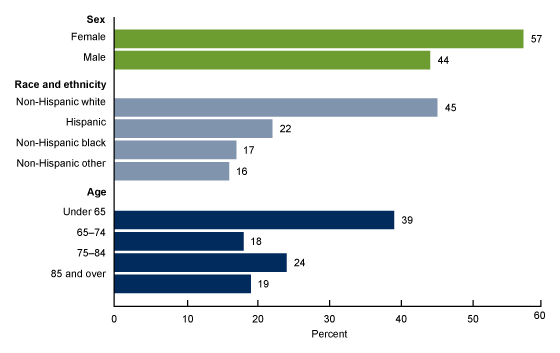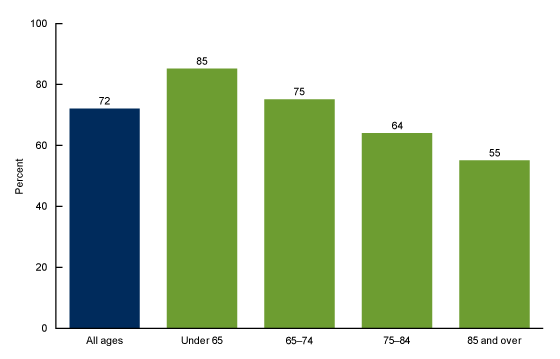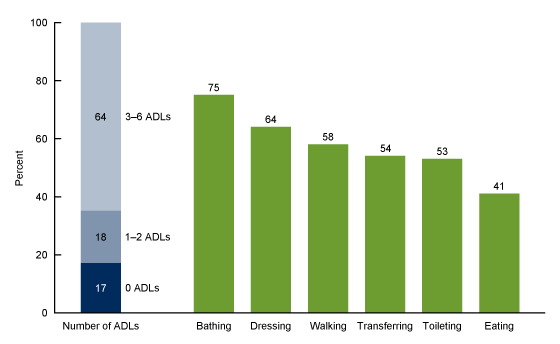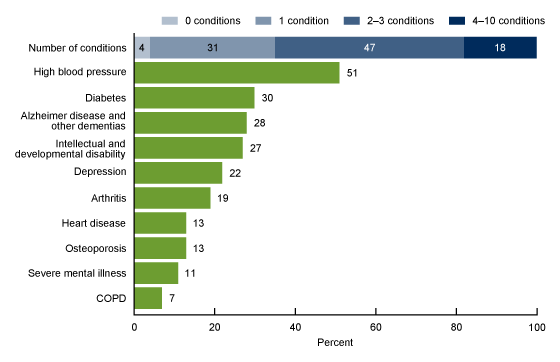Adult Day Services Center Participant Characteristics: United States, 2018
NCHS Data Brief No. 411, September 2021
PDF Version (481KB)
- Key findings
- Most ADSC participants were female, of a race and ethnicity group other than non-Hispanic white, and aged 65 and over.
- Most ADSC participants were Medicaid beneficiaries, and the percentage of participants with Medicaid varied by age.
- ADSC participants needed the most assistance with bathing, dressing, and walking; almost two-thirds of participants needed assistance with three to six ADLs.
- Most participants were diagnosed with two to three of the most common chronic conditions, and slightly more than one-half of participants were diagnosed with high blood pressure.
- Summary
Data from the 2018 National Study of Long-Term Care Providers
- In 2018, about 57% of adult day services center (ADSC) participants were female, 45% were non-Hispanic white, and 39% were under age 65.
- Most ADSC participants were Medicaid beneficiaries (72%); about 85% of participants under age 65 were Medicaid beneficiaries.
- About 64% of participants needed assistance with three or more activities of daily living.
- Most ADSC participants had two or three chronic conditions; just over one-half of participants were diagnosed with high blood pressure.
An estimated 251,100 participants were enrolled in adult day services centers (ADSCs) in the United States in 2018 (1). Compared with users of other long-term care services, ADSC participants were younger and more racially and ethnically diverse (2). ADSC participants have a diverse set of needs, with many participants requiring assistance with activities of daily living (ADLs) and having chronic health conditions (3). This report presents national estimates of selected characteristics of participants of ADSCs from the 2018 National Study of Long-Term Care Providers.
Keywords: Medicaid, activities of daily living (ADLs), home and community-based services, National Study of Long-Term Care Providers
Most ADSC participants were female, of a race and ethnicity group other than non-Hispanic white, and aged 65 and over.
- Almost 6 in 10 participants of ADSCs were female (57%) (Figure 1).
- Most ADSC participants were of a race and ethnicity other than non-Hispanic white (55%); 45% were non-Hispanic white, 22% were Hispanic, 17% were non-Hispanic black, and 16% were non-Hispanic other.
- Most ADSC participants were aged 65 and over (61%); 39% were aged under 65, 42% were aged 65–85, and 19% were aged 85 and over.
Figure 1. Sex, race and ethnicity, and age of adult day services center participants: United States, 2018

NOTES: Non-Hispanic other includes non-Hispanic American Indian or Alaska Native; non-Hispanic Asian; non-Hispanic Native Hawaiian or Other Pacific Islander; and non-Hispanic persons of more than one race. Figure excludes cases with missing data. See Data source and methods for details. Percentages are based on unrounded numbers; estimates may not sum to totals because of rounding. Access data table for Figure 1.
SOURCE: National Center for Health Statistics, National Study of Long-Term Care Providers, 2018.
Most ADSC participants were Medicaid beneficiaries, and the percentage of participants with Medicaid varied by age.
- Overall, 72% of participants were Medicaid beneficiaries (Figure 2).
- By age, 85% of participants under age 65, 75% of participants aged 65–74, 64% of participants aged 75–84, and 55% of participants aged 85 and over were Medicaid beneficiaries.
Figure 2. Adult day services center participants with Medicaid, overall and by age: United States, 2018

NOTES: Refers to participants who had some or all of their long-term care services paid by Medicaid during last complete month prior to the survey. This includes any funding from a Medicaid state plan, Medicaid waiver, Medicaid managed care, or California regional center. Figure excludes cases with missing data. See Data source and methods for details. Access data table for Figure 2.
SOURCE: National Center for Health Statistics, National Study of Long-Term Care Providers, 2018.
ADSC participants needed the most assistance with bathing, dressing, and walking; almost two-thirds of participants needed assistance with three to six ADLs.
- Among ADSC participants, 17% did not need assistance with any ADL, 18% needed assistance with one or two ADLs, and 64% needed assistance with three to six ADLs (Figure 3).
- Most commonly, participants needed assistance with bathing (75%), followed by dressing (64%), and walking (58%).
- Approximately one-half of participants needed assistance with transferring from a chair (54%) and toileting (53%).
- About 41% of participants needed assistance with eating.
Figure 3. Adult day services center participants needing assistance with activities of daily living: United States, 2018

NOTES: Activities of daily living (ADLs) refers to participants needing any help or supervision from another person, or use of assistive devices, or both, at their usual residence or at the center, due to limitations in up to six ADLs (transferring in and out of a chair; eating, such as cutting up food; dressing; bathing or showering; toileting; and walking). Individual ADLs are not mutually exclusive; a participant can be counted in more than one ADL. Figure excludes cases with missing data. See Data source and methods for details. The estimate for the number of ADLs may not add to 100 because of rounding. Access data table for Figure 3.
SOURCE: National Center for Health Statistics, National Study of Long-Term Care Providers, 2018.
Most participants were diagnosed with two to three of the most common chronic conditions, and slightly more than one-half of participants were diagnosed with high blood pressure.
- Eighteen percent of ADSC participants had ever been diagnosed with 4–10 of the most common chronic conditions, 47% had ever been diagnosed with 2–3 of the most common chronic conditions, 31% had ever been diagnosed with one of these chronic conditions, and 4% had never been diagnosed with these conditions (Figure 4).
- The four most reported diagnoses were high blood pressure (51%), diabetes (30%), Alzheimer disease and other dementias (28%), and intellectual and developmental disabilities (27%).
- Participants also reported diagnoses of depression (22%), arthritis (19%), heart disease (13%), osteoporosis (13%), severe mental illness (11%), and chronic obstructive pulmonary disease (COPD) (7%).
Figure 4. Most common chronic conditions of adult day services center participants: United States, 2018

NOTES: Heart disease includes coronary or ischemic heart disease. COPD is chronic obstructive pulmonary disease and includes chronic bronchitis or emphysema. Individual conditions are not mutually exclusive; a participant can be counted in more than one condition. Figure excludes cases with missing data. See Data source and methods for details. Access data table for Figure 4.
SOURCE: National Center for Health Statistics, National Study of Long-Term Care Providers, 2018.
Summary
In 2018 in the United States, most ADSC participants were female (57%), of a race and ethnicity other than non-Hispanic white (55%), and aged 65 and over (61%). Over three-quarters of ADSC participants needed assistance with at least one in six ADLs and most participants needed assistance with three to six ADLs. Bathing was the most common ADL that required assistance. Almost two-thirds of participants were diagnosed with at least two chronic conditions. The most common chronic conditions were high blood pressure, diabetes, and Alzheimer disease and other dementias.
This report presents the most current national estimates of selected characteristics of ADSC participants in the United States. These data provide information to researchers, policy makers, and others as they plan to address the needs of adults within home- and community-based care settings.
Definitions
Adult day services center: A community-based center, generally open on weekdays, that provides long-term and post-acute care services, including structured activities, health monitoring, socialization, and assistance with activities of daily living (ADLs) to adults with disabilities.
Assistance with selected activities of daily living (ADLs): Refers to participants needing any help or supervision from another person, or use of assistive devices, or both, at their usual residence or at the center, due to limitations in up to six ADLs (transferring in and out of a chair; eating, such as cutting up food; dressing; bathing or showering; toileting; and walking).
Chronic obstructive pulmonary disease (COPD): Includes chronic bronchitis or emphysema.
Heart disease: Includes coronary or ischemic heart disease.
Other race and ethnicity: Includes non-Hispanic American Indian or Alaska Native; non-Hispanic Asian; non-Hispanic Native Hawaiian or Other Pacific Islander; and non-Hispanic persons of more than one race.
Medicaid beneficiaries: Refers to participants who had some or all of their long-term care services paid by Medicaid during last complete month prior to the survey. This includes any funding from a Medicaid state plan, Medicaid waiver, Medicaid managed care, or California regional center.
Data source and methods
Data for this report are from the ADSC component of the 2018 wave of the biennial National Study of Long-Term Care Providers (NSLTCP), conducted by the National Center for Health Statistics. The survey used a sample of ADSC participants, obtained from a national sample of ADSCs that were operating in the United States in 2018. More details about NSLTCP, including eligibility criteria, design, and outcomes, are published elsewhere (4).
The percentage of cases with missing data for variables in this report ranged from 0.8% for transferring to 4.7% for bathing. These cases were excluded from the analyses on a variable-by-variable basis. Data analyses were performed using STATA/SE version 14 (5). Analyses incorporated complex survey weights.
About the authors
Jessica Penn Lendon and Priyanka Singh are with the National Center for Health Statistics, Division of Health Care Statistics, Long-Term Care Statistics Branch.
References
- National Center for Health Statistics. 2018 National Study of Long-Term Care Providers survey methodology for the Residential Care Community and the Adult Day Services Center components. 2021.
- Lendon JP, Rome V, Sengupta M. Variations between adult day services centers in the United States by the racial and ethnic case-mix of center participants [published online ahead of print, 2020 Jul 2]. J Appl Gerontol. 2020.
- Harris-Kojetin L, Sengupta M, Lendon JP, Rome V, Valverde R, Caffrey C. Long-term care providers and services users in the United States, 2015–2016. National Center for Health Statistics. Vital Health Stat 3(43). 2019.
- National Center for Health Statistics. 2018 National Study of Long-Term Care Providers Adult Day Services Center (ADSC) Participant restricted data file: Data description and usage. 2021.
- StataCorp. Stata Statistical Software (Release 14) [computer software]. 2015.
Suggested citation
Lendon JP, Singh P. Adult day services center participant characteristics: United States, 2018. NCHS Data Brief, no 411. Hyattsville, MD: National Center for Health Statistics. 2021. DOI: https://dx.doi.org/10.15620/cdc:106697.
Copyright information
All material appearing in this report is in the public domain and may be reproduced or copied without permission; citation as to source, however, is appreciated.
National Center for Health Statistics
Brian C. Moyer, Ph.D., Director
Amy M. Branum, Ph.D., Associate Director for Science
Division of Health Care Statistics
Carol J. DeFrances, Ph.D., Acting Director
Alexander Strashny, Ph.D., Associate Director for Science